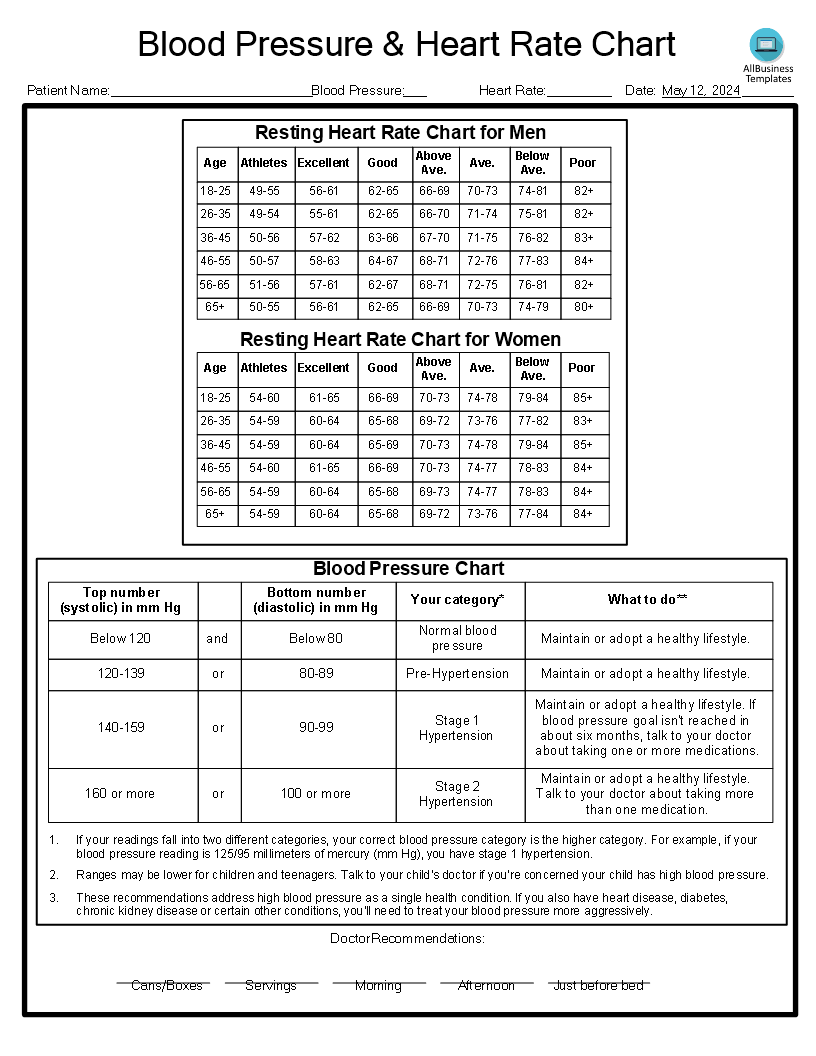Heart Rate Chart
Save, fill-In The Blanks, Print, Done!

Download Heart Rate Chart
Microsoft Word (.docx)Or select the format you want and we convert it for you for free:
- This Document Has Been Certified by a Professional
- 100% customizable
- This is a digital download (30.57 kB)
- Language: English
- We recommend downloading this file onto your computer.
What does the heart rate chart mean? Have you been looking for a template for a heart rate chart? This template can be used to track your heart rate over time, and can also be used to compare your heart rate with other users. Download this template which is very simple and easy to use.
A heart rate chart typically represents the beats per minute (BPM) of a person's heart over some time. It can convey several pieces of information:
- Heart Rate Variability: The chart may show fluctuations in heart rate over time. This variability can indicate the responsiveness of the autonomic nervous system, which regulates heart function. Higher variability is generally considered a sign of good cardiovascular health.
- Resting Heart Rate: By observing the baseline heart rate when a person is at rest, healthcare providers or individuals can assess overall cardiovascular fitness. A lower resting heart rate often indicates better cardiovascular health, as it suggests the heart doesn't need to work as hard to circulate blood.
- Exercise Intensity: During physical activity, the heart rate typically increases to meet the body's increased oxygen demands. A heart rate chart can illustrate how heart rate responds to different levels of exercise intensity, helping individuals optimize their workouts for improved fitness.
- Recovery Rate: After exercise, the heart rate should gradually return to its resting level. The rate at which it does so can provide insights into cardiovascular fitness and recovery efficiency. A quicker return to baseline suggests better cardiovascular conditioning.
- Monitoring Health: Tracking changes in heart rate over time can help identify trends or irregularities that may indicate underlying health issues such as arrhythmias, stress, or fatigue. It can be a valuable tool for both self-monitoring and medical assessment.
In summary, a heart rate chart provides a visual representation of how the heart responds to various stimuli and can be used to assess cardiovascular health, track fitness progress, and monitor overall well-being.
You can open our sample heart rate chart template directly by clicking on the 'Open with Google Docs' button or you can download it as a Word file now to enhance your efficiency!
DISCLAIMER
Nothing on this site shall be considered legal advice and no attorney-client relationship is established.
Leave a Reply. If you have any questions or remarks, feel free to post them below.
Related templates
Latest templates
Latest topics
- Certificate Template
How to create a professional-looking Certificate? Browse through our impressive database of great looking Certificate templates and find a suitable one! - Wedding Invitation Templates
How to get free wedding invitation templates? Where to find Do It Yourself Wedding invitations templates? Download them here! - Google Docs Templates
How to create documents in Google Docs? We provide Google Docs compatible template and these are the reasons why it's useful to work with Google Docs... - Excel Templates
Where do I find templates for Excel? How do I create a template in Excel? Check these editable and printable Excel Templates and download them directly! - GDPR Compliance Templates
What do you need to become GDPR compliant? Are you looking for useful GDPR document templates to make you compliant? All these compliance documents will be available to download instantly...
cheese

